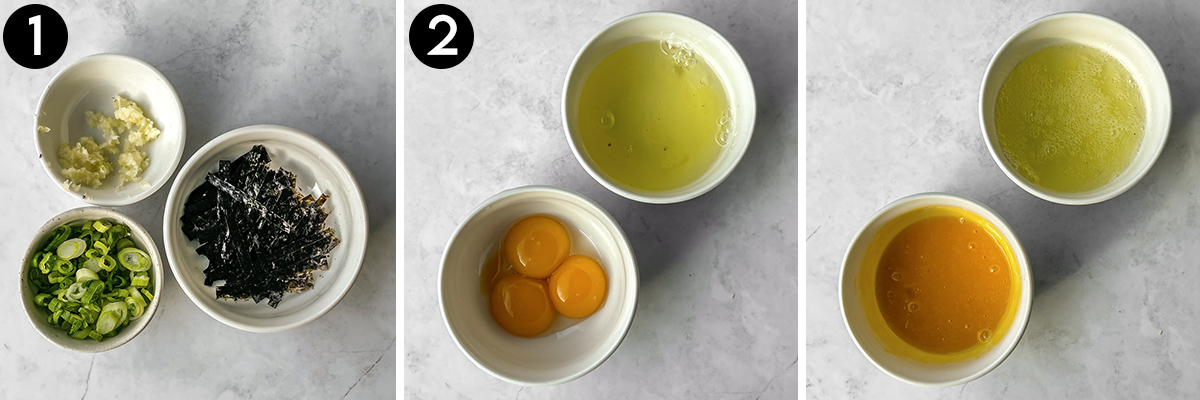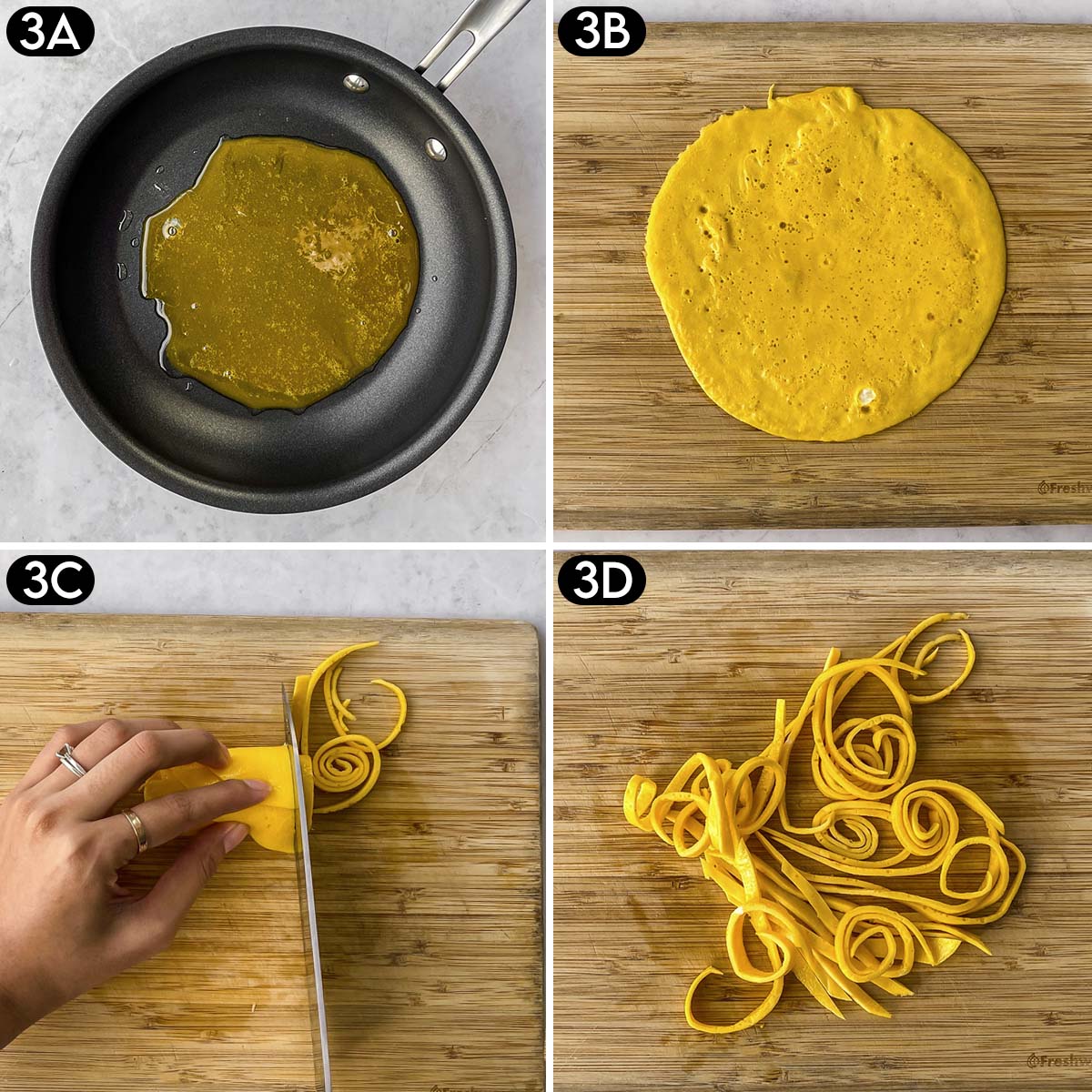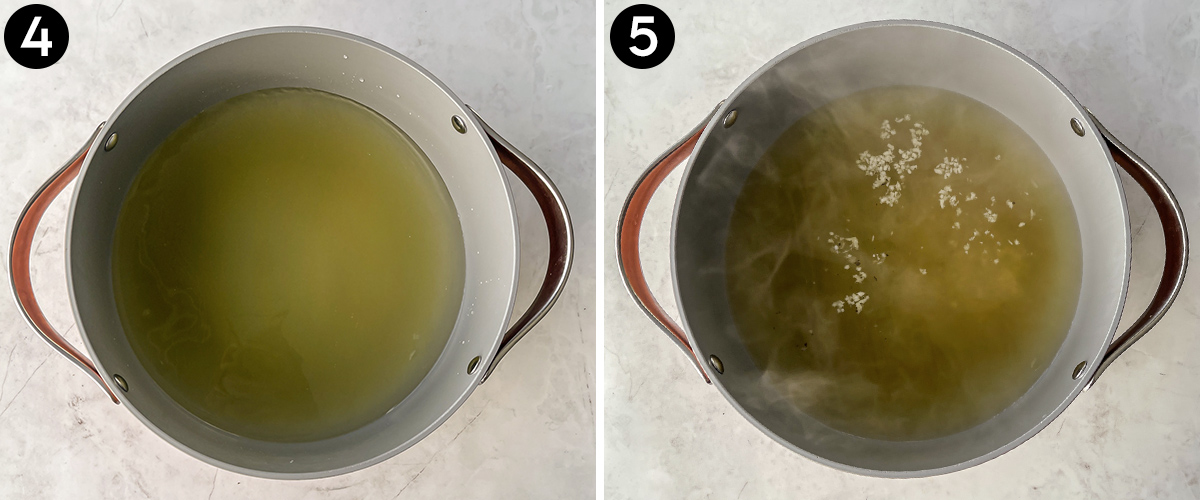Dduk Mandu Guk (떡만두국), or Korean Rice Cake and Dumpling Soup, is a traditional New Year's Day recipe that's also delicious winter comfort food. Thin rice cakes, plump dumplings, and poached egg whites float in a light and flavorful broth. It's then topped with seaweed and egg strips for the perfect finish.

Jump to:
🥟 What Is Dduk Mandu Guk?
Tteokguk (떡국) is a traditional Korean dumpling soup that's served during the Lunar New Year (or Seollal, 설날) celebrations. When translated, dduk/ddeok/teok/tteok means rice cake and guk means broth or soup. The addition of mandu (dumplings) turns the dish into Dduk Mandu Guk or Tteok Mandu Guk (떡만두국). So, all together it translates to "dumpling rice cake soup" or "rice cake and dumpling soup".
Dduk Mandu Guk is simple and comforting, which is why it's a favorite for a cold or sick day. In the winter, it's on constant rotation along with my Instant Pot Chao Ga (Vietnamese Rice Porridge) and Vietnamese Macaroni Soup with Pork (Sup Nui).
A Traditional Korean Soup Recipe
My husband is Korean and it's been exciting incorporating Korean traditions into our holidays and celebrations. Of course, the most fun has been learning how to make authentic Korean food. Rabokki (Tteokbokki + Ramen) and Bibimmyeon (Korean Cold Spicy Noodles) are just some of my new favorites.
But for every New Year's and/or Lunar New Year, Tteok Mandu Guk is a must. The light yet hearty broth delivers nutrients and warmth while rice cakes and eggs create a cloudy texture. Use your favorite mandu dumpling flavors to make it your own! But don't forget the signature toppings: thin strips of seaweed and cooked egg, plus plenty of sesame seeds.
Each family has their own variation of Korean Rice Cake and Dumpling Soup, but I like to keep it simple. Shredded beef is a popular addition, but mandu dumplings are filling enough for us. I also prefer the quick cook time without additional protein because the faster I can get Dduk Mandu Guk on the table, the happier my family is!
Why You'll Love It
- Quick and easy: This healthy Korean Rice Cake and Dumpling Soup is a breeze to whip up thanks to the use of supermarket shortcuts and pantry staples. You only need 10 ingredients and 30 minutes to create this simple soup!
- Comforting: Tteok Mandu Guk is a favorite amongst kids and adults. This is the perfect recipe for when you need a fast yet flavorful meal on the table.
- Perfect for the holidays: This is a traditional New Year's dish in Korean culture that's believed to bring good luck. The white rice cakes symbolize purity and new beginnings, and its shape resembles coins for fortune.
🧂 Ingredients

- Eggs: Egg whites are used to add texture and protein to the broth. Meanwhile, the egg yolks are cooked separately and added on top for color and flavor.
- Cooking oil: Avocado oil is my favorite oil to cook, fry, and sauté with because of its high smoke point (500°F).
- Broth: I prefer to use chicken bone broth for this recipe. Feel free to use beef or vegetable broth instead - even water would work. I recommend using a low-sodium broth for better control of the seasoning.
- Garlic: Adds fragrance to the soup.
- Fish sauce: A a popular Southeast Asian condiment made from salted and fermented anchovies. It's a staple in my kitchen and I use it in almost all of my recipes like Vietnamese Fish Sauce Chicken Wings and Thit Nuong (Vietnamese Pork Skewers). It's salty, funky, and umami-rich, adding tons of depth to Tteok Mandu Guk.
- Flat rice cakes (tteok): Thinly sliced rice cakes are traditional for tteokguk. You can find them in the refrigerated aisles near the fresh noodles in most Asian markets. It's also available on Weee!.
- Mandu (dumplings): Pre-made mandu is a huge timesaver for this recipe, but you can also make your own. Any flavor would work. Frozen dumplings can be found at all Asian markets, but Korean markets will have a wider variety of traditional mandu. I've also seen them at Costco. Another alternative is to ask your local Korean restaurant if they will sell them to you uncooked (fresh or frozen).
- Sesame oil: Used as a primary flavor component of the broth.
- Seaweed: Use toasted seaweed sheets and create strips for the traditional garnish. If you have a lot of leftovers, try using them in Spam Musubi with Egg or Jumeokbap (Korean Rice Balls).
- Sesame seeds and green onion: for garnish.
Substitutions & Variations
- Leave out the mandu to make a simple tteokguk (Korean Rice Cake Soup).
- Mix and match your favorite flavor of dumplings to satisfy all your tastebuds and make this Dduk Mandu Guk your own.
- Include protein like shredded chicken or brisket for a heartier meal.
- If you don’t have fish sauce on hand, swap it out with anchovy stock or chicken or beef bouillon instead. You could also season with soy sauce or soup soy sauce instead, but the flavor will be different.
👩🏻🍳 How To Make Dduk Mandu Guk
⬇️ Please scroll down to the recipe card to see full ingredient amounts and instructions.

STEP ONE: The first steps involves the minimal prep for this recipe. Mince the garlic, slice the green onion, and make the seaweed strips. For the seaweed, I find kitchen shears work better than knives.
STEP TWO: Then separate the 3 eggs. Season both the yolks and whites separately, then whisk until frothy.

STEP THREE: Next, cook the egg yolks for the garnish. Heat a splash of oil in a skillet over medium heat. Pour the egg yolks in and tilt the pan to create a very thin layer. Let sit to cook for 2-3 minutes, then flip and repeat. Transfer to a cutting board.
Cut the egg circle in half or thirds across the equator. Stack the sections up and roll. Then slice to create long thin strips of egg. Set aside.

STEP FOUR: Pour broth and/or water into a large pot. Cover and bring to a boil, then turn the heat down so it's at a rolling simmer.
STEP FIVE: Season with garlic, fish sauce, salt, and pepper to taste.

STEP SIX: Add the rice cakes in first. Cook for 3-5 minutes, stirring often to prevent them from sticking to the bottom of the pot. If using dumplings straight from the freezer, add them in at the same time as the tteok.
STEP SEVEN: Then add the mandu dumplings if you haven't already. Cook for an additional 3-4 minutes until both the tteok and mandu start to float.

STEP EIGHT: While stirring, slowly drizzle in the egg whites in increments. The soup should begin to look cloudy as the egg whites poach.
STEP NINE: Finally, pour in the sesame oil to finish the Tteok Mandu Guk. Season to taste with more fish sauce and/or salt and pepper as needed. Divide into individual bowls and top with green onion, egg yolk strips, and sesame seeds. Serve immediately.

💭 Top Tips
- Use kitchen shears instead of knives to cut the seaweed sheet into thin strips to prevent tearing. You could also use them to thinly slice the cooked egg yolk and green onion.
- Gauge the cooking time based on the mandu and rice cakes you're using. Fresh ingredients will cook much faster than their frozen counterparts. You’ll know they're finished when they're float.
- Stir the rice cakes often to prevent them from sticking to the pot.
- Serve your Dduk Mandu Guk right away! Otherwise, the tteok and mandoo will bloat and become mushy.
What To Serve with Korean Rice Cake and Dumpling Soup
Feel free to serve this Korean Mandu Soup on its own as a light and nourishing meal. However, if you're making this for the holidays, I love having a big spread for the family. Try serving it alongside:
- Bulgogi
- Korean Popcorn Chicken
- Vietnamese Crispy Pork Belly (Thit Heo Quay)
- A wide assortment of banchan, or traditional Korean side dishes, and kimchi
- Mi Xao Gion (Vietnamese Crispy Pan Fried Noodles)
- Gochujang Salmon

🥡 Storing & Freezing
Tteok Mandu Guk must be served immediately! Otherwise, the rice cakes and dumplings will bloat and become soggy.
To make it ahead of time, you can prepare the broth in advance without the poached egg whites. Let cool completely before storing it in the fridge in an air-tight container for 2-3 days or in the freezer for up to 3 months.
Complete the dish day-of by heating the broth in a pot over medium heat, covered. Cook the rice cakes, mandu, and toppings as directed and serve immediately.
📖 Recipe FAQs
In the past, rice was scarce and consumed only on special occasions such as during Seollal (the Lunar New Year) in this Duk mandoo guk recipe. Therefore, the soup grew to represent a culinary treat and special occasion.
However, it’s also eaten because of the symbolism for which it stands. For instance, in Korean culture, the white tteok symbolizes purity and cleanliness or a new start. Meanwhile, the coin-like shape of the rice cakes resembles money and is meant to represent prosperity. It is also said that to become a year older, one must consume a bowl of Dduk Mandu Guk on the new year.
Tteokguk is a traditional New Year's recipe that's served to remind us of the meaning of the new year and family. It represents the revival of all of Earth’s creatures, new beginnings, and becoming new or fresh.
Technically, you do not need to soak the rice cakes. However, doing so will help them soften and separate reducing the cooking time, especially if you are using frozen rice cakes!
🍽 Looking For More Asian Recipes?
Love this recipe? Please leave a 5-star 🌟🌟🌟🌟🌟 rating in the recipe card below and consider leaving a comment. It's always greatly appreciated!
📋 Recipe

Dduk Mandu Guk
Ingredients
- 3 eggs
- ½ tablespoon cooking oil
- 6 cups low-sodium chicken broth and/or water
- 2-3 cloves garlic minced
- 1½ tablespoon fish sauce
- 1 lb flat rice cakes (tteok) thawed (see notes)
- ½-¾ lb mandu (dumplings) fresh or frozen
- 1 teaspoon sesame oil
- 1-2 green onion thinly sliced; for garnish
- ½ sheet roasted seaweed sheets (sushi nori) cut into thin strips; for garnish
- Sesame seeds for garnish
- Kosher salt and pepper to taste
Instructions
- Prepare the eggs. Separate egg yolks from egg whites and place into 2 separate bowls. Add ⅛ teaspoon salt to egg yolks. Whisk each separately.
- Heat oil in a non-stick skillet over medium heat. Pour in egg yolks and tilt pan to form a thin layer. Cook for 2-3 minutes each side, then slide out onto cutting board. Roll and cut into thin strips. Set aside for garnish.
- Start the soup. Pour your broth or water into a large pot. Cover and bring to a boil, then turn heat down to a rolling simmer. Stir in garlic, fish sauce, ¼ teaspoon salt, and ¼ teaspoon pepper.
- Add the rice cakes and mandu dumplings to the broth. Cook for 2-4 minutes uncovered or until they start to float, stirring often to prevent them from sticking to the bottom.
- Turn heat down to medium-low. While stirring the soup, slowly pour in egg whites to create ribbons. Then pour in sesame oil and season to taste with salt and/or fish sauce.
- Serve immediately and top with green onion, egg yolk, seaweed strips, and sesame seeds.
Notes
- Flat rice cakes (tteok): Thinly sliced cylindrical rice cakes are traditional for tteokguk. They can be find fresh, refrigerated, or frozen and are most readily available at Asian markets or on Weee! but they're now available at Trader Joe's as well.
- The cooking time will vary depending on what type of tteok you use. Fresh rice cakes only need to cook for 1-2 minutes while refrigerated (or thawed from frozen) will require 2-4 minutes.
- Mandu (dumplings): Pre-made mandu is a huge timesaver for this recipe, but you can also make your own. Any flavor would work. Frozen dumplings can be found at all Asian markets, but Korean markets will have a wider variety of traditional mandu. I've also seen them at Costco. Another alternative is to ask your local Korean restaurant if they will sell them to you uncooked (fresh or frozen).
- Broth: I prefer to use chicken bone broth for this recipe. Feel free to use beef or vegetable broth instead - even water would work. I recommend using a low-sodium broth for better control of the seasoning.
- If you don’t have fish sauce on hand, swap it out with anchovy stock or chicken or beef bouillon instead. You could also season with soy sauce or soup soy sauce instead, but the flavor will be different.
- Tteok Mandu Guk must be served immediately! Otherwise, the rice cakes and dumplings will bloat and become soggy.
- To make this ahead of time, you can prepare the broth in advance without the poached egg whites. Let cool completely before storing it in the fridge in an air-tight container for 2-3 days or in the freezer for up to 3 months. Complete the dish day-of by heating the broth in a pot over medium heat, covered. Cook the rice cakes, mandu, and toppings as directed and serve immediately.











Comments
No Comments